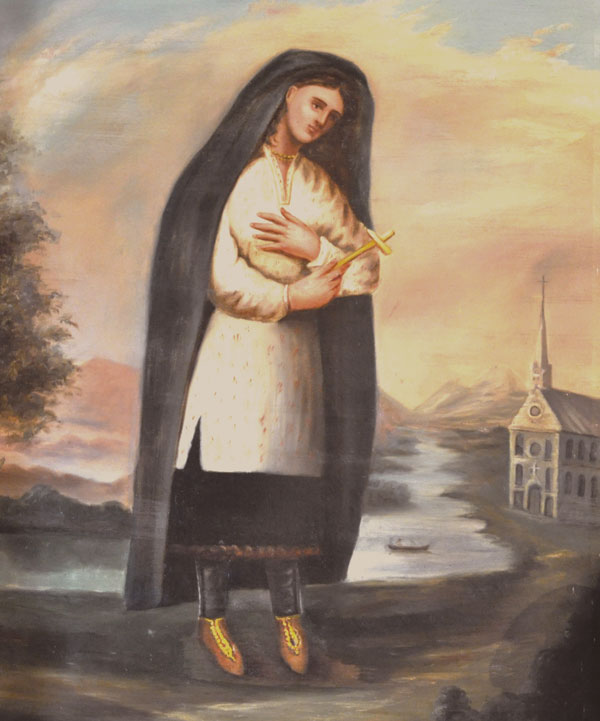
Mohawk Princess, Patroness of Ecology and of Youth
St. Kateri Tekawitha
History has proven there the famous statement of Tertullian “The blood of the martyrs is the seed of the Church”. In 1656, nine years after the martyrdom of Jesuit missionaries Isaac Jogues and Jean de Brébeuf, Kateri Tekakwitha, the “Lily of the Mohawks” was born near modern day Auriesville, New York. At the age of four, she lost both parents and her little brother to a smallpox epidemic. While she survived the illness, it left her face badly scarred and her eyesight impaired. Her disability earned her the name, “Tekakwitha”, which means, “she who bumps into things.” She was adopted by her uncle, who succeeded her father as the Mohawk Chief. He was strongly opposed to Christianity and the “blackrobes” (Jesuit missionaries) who preached it. But due to a peace treaty with the French, the missionaries were required to be at the side of Christian captives in the village, and it was forbidden to harm them.
Kateri was moved by the words of the Jesuit missionaries, and secretly received instructions in the Catholic faith at the age of eighteen. Her uncle finally gave in, and she was baptized on Easter Sunday, April 5th, 1676. She lived with the dignity of a Christian, marked by a life of virtue and joy in the face of a home filled with carnage and idolatry. She pledged her life to Jesus as a virgin, and firmly refused all efforts at being married off, often at great risk to herself. “I am not my own,” she said, “I have given myself entirely to Jesus Christ; He must be my only love.” Her identity as a Christian led her village to hold her in contempt. She united her sufferings to Jesus when she was unjustly mocked, accused, and her life was threatened.
She escaped to a settlement of Christian Indians in Canada, the Mission of St. Francis Xavier, where her faith continued to flourish. On Christmas Day in 1677, Kateri made her First Holy Communion, and made a vow of perpetual virginity on the Feast of the Annunciation in 1679. She was devoted to the Cross and the Blessed Sacrament, often walking barefoot in snow and ice in order to go to Mass and to pray in the chapel. Her vision was drawn towards Heaven, always willing to suffer for the sake of her Beloved, saying, “I will willingly abandon this miserable body to hunger and suffering, provided that my soul may have its ordinary nourishment.” On the settlement, she was known for her gentle kindness, and taught prayers to the children. The love of Christ was evident in her charity as she cared for the sick and elderly.
“A chapel of wood is not what God wants; He wants our souls to make a temple of them.”
She died on April 17th, 1680 at the age of twenty-four. Her final words were, “Jesus, I love you.” Witnesses at her deathbed marveled at the sight of her face because all the evidence of smallpox vanished fifteen minutes after she died. She was so radiant and peaceful that onlookers passing her cabin believed she was sleeping; when they were told otherwise, they quickly rushed back to commend themselves to her prayers. It wasn’t long after her death that miracles attributed to her intercession were reported. People on the brink of death were given the crucifix held by Kateri when she died, and they were miraculously healed. She was canonized on October 21st, 2010 by Pope Benedict XVI as the first Native American to be declared a saint.
Feast Day: July 14
*This image of St. Kateri was painted by her spiritual director, Fr. Claude Chauchetiere S.J.

